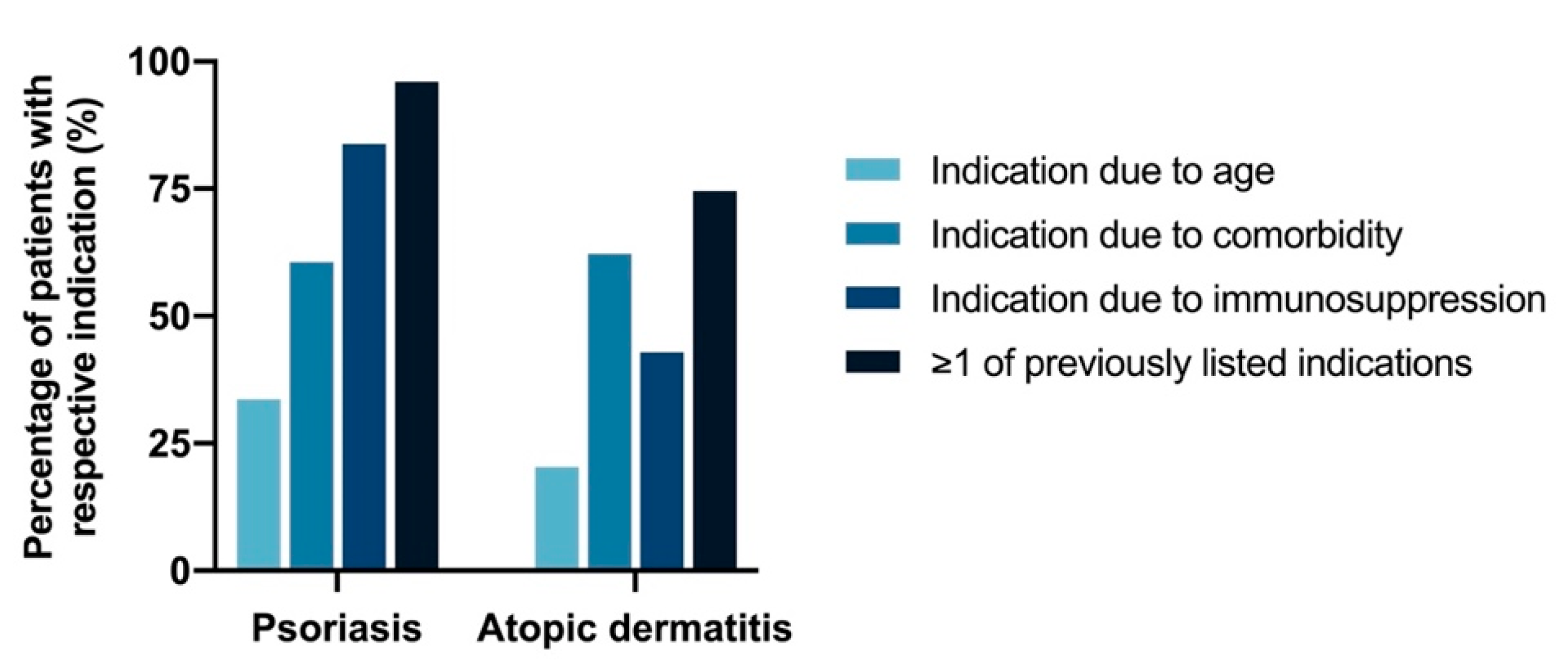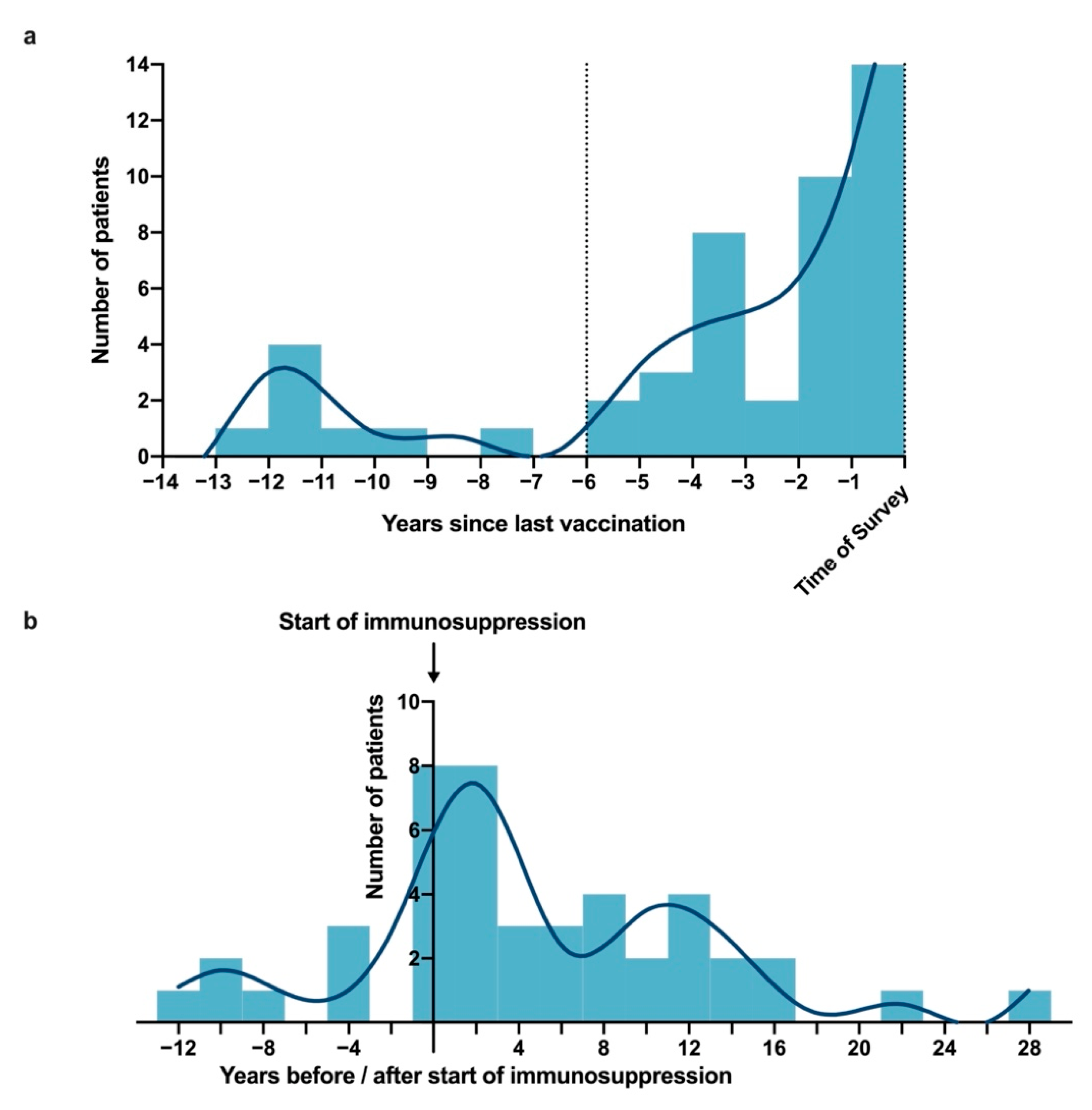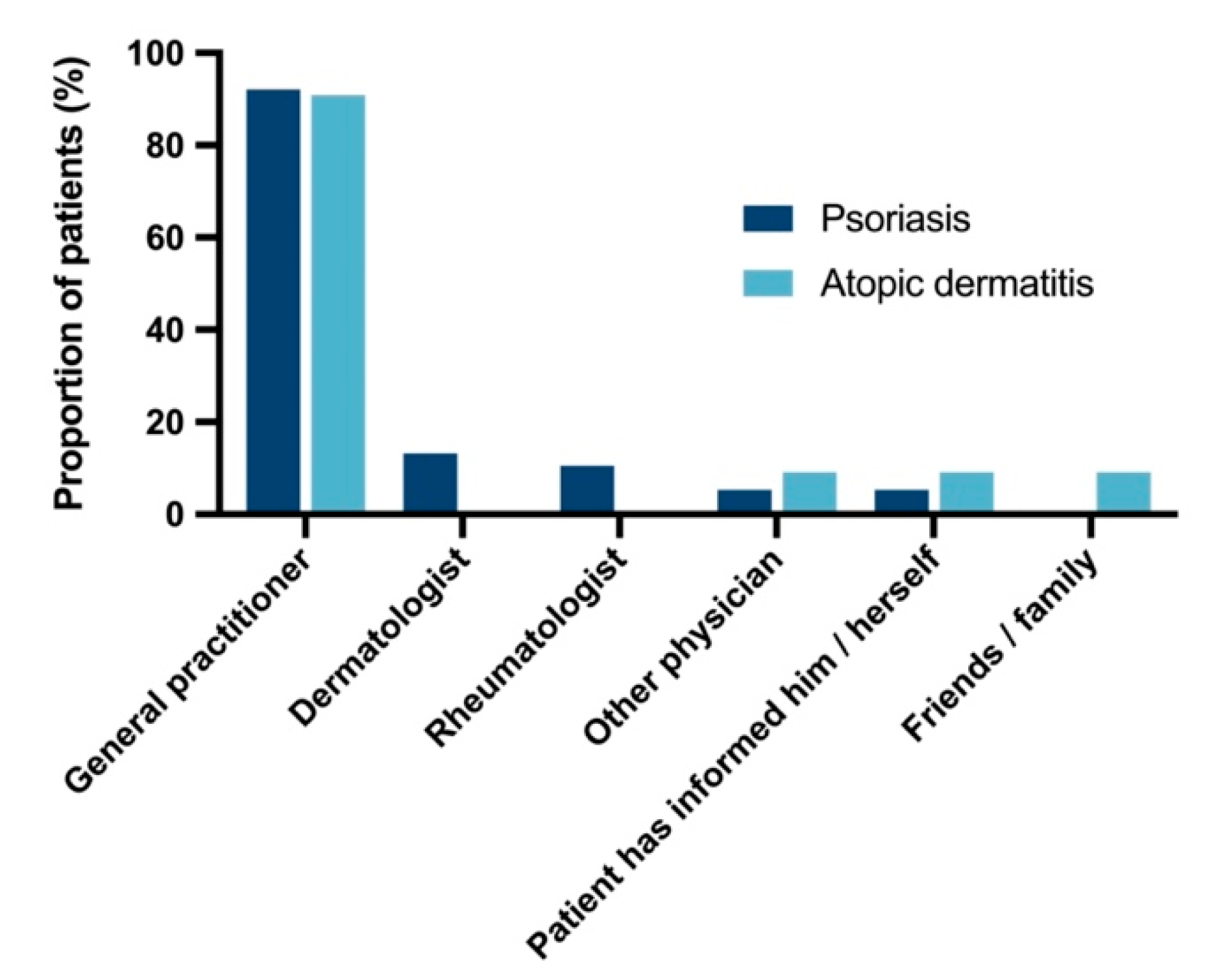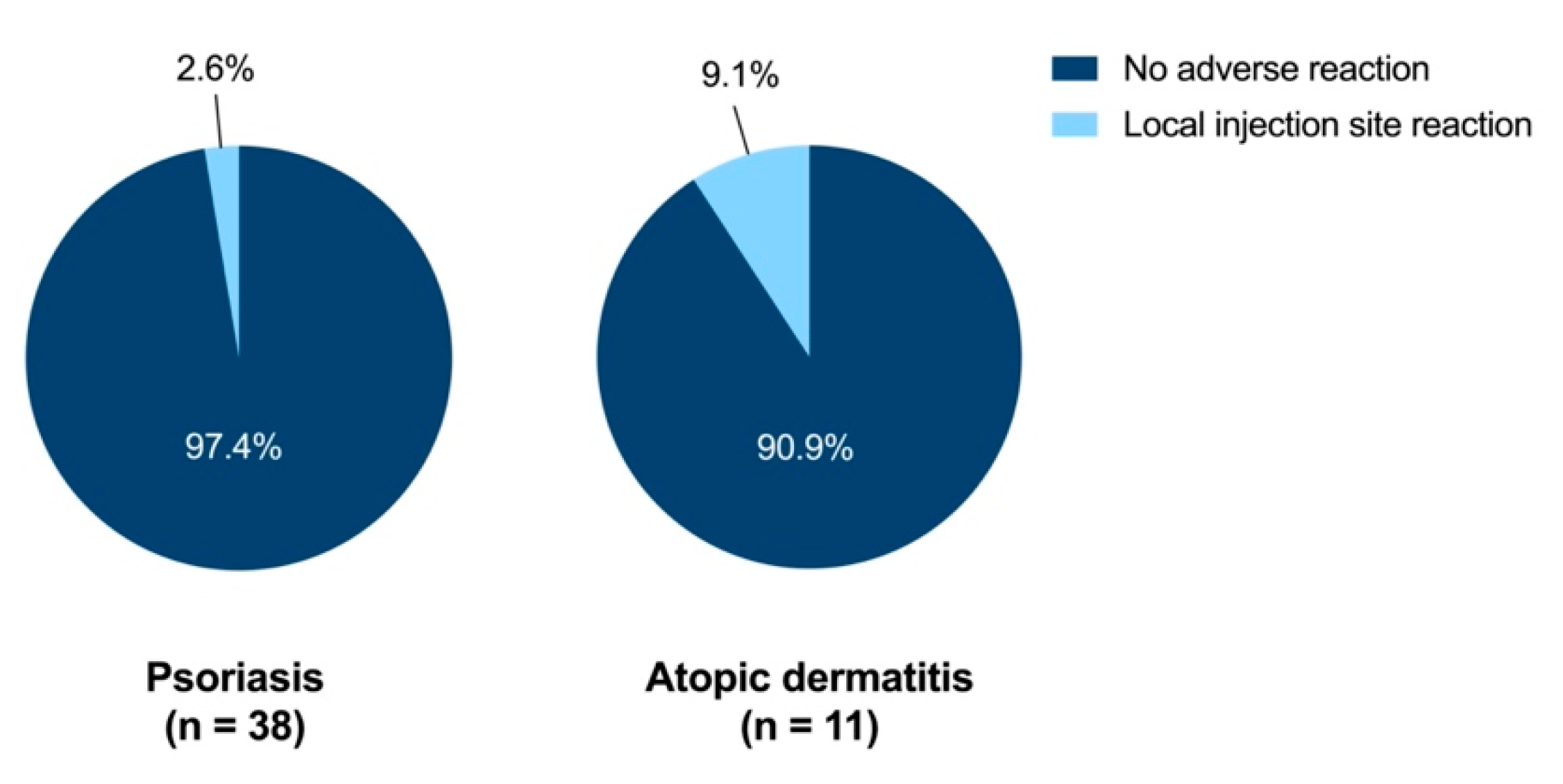Low Pneumococcal Vaccination among Patients with Psoriasis in Germany: Results from Vac-Pso
Abstract
:1. Introduction
2. Materials and Methods
2.1. Study Design
2.2. Data Collection
2.3. Statistical Analysis
3. Results
3.1. Study Cohort
3.2. Pneumococcal Vaccination Rate
3.3. Recommendation and Patient Perspectives
4. Discussion
Supplementary Materials
Author Contributions
Funding
Institutional Review Board Statement
Informed Consent Statement
Data Availability Statement
Conflicts of Interest
References
- Schön, M.; Boehncke, W.H. Psoriasis. N. Engl. J. Med. 2005, 325, 1899–1912. [Google Scholar] [CrossRef] [PubMed]
- Ryan, C.; Kirby, B. Psoriasis is a systemic disease with multiple cardiovascular and metabolic comorbidities. Dermatol. Clin. 2015, 33, 41–55. [Google Scholar] [CrossRef] [PubMed]
- Gottlieb, A.B.; Chao, C.; Dann, F. Psoriasis comorbidities. J. Dermatol. Treat. 2008, 19, 5–21. [Google Scholar] [CrossRef] [PubMed]
- Wine-Lee, L.; Keller, S.C.; Wilck, M.B.; Gluckmann, S.J.; Van Voorhees, A.S. From the Medical Board of the National Psoriasis Foundation: Vaccination in adult patients on systemic therapy for psoriasis. J. Am. Acad. Dermatol. 2013, 69, 1003–1013. [Google Scholar] [CrossRef]
- Nast, A.; Boehncke, W.H.; Mrowietz, U.; Ockenfels, H.M.; Philipp, S.; Reich, K.; Rosenbach, T.; Sammain, A.; Schlaeger, M.; Sebastian, M.; et al. German S3-guidelines on the treatment of psoriasis vulgaris (short version). Arch. Dermatol. Res. 2012, 304, 87–113. [Google Scholar] [CrossRef]
- Wakkee, M.; de Vries, E.; van den Haak, P.; Nijsten, T. Increased risk of infectious disease requiring hospitalization among patients with psoriasis: A population-based cohort. J. Am. Acad. Dermatol. 2011, 65, 1135–1144. [Google Scholar] [CrossRef]
- Kao, L.T.; Lee, C.Z.; Liu, S.P.; Tsai, M.C.; Lin, H.C. Psoriasis and the risk of pneumonia: A population-based study. PLoS ONE 2014, 9, e116077. [Google Scholar] [CrossRef]
- Takeshita, J.; Shin, D.B.; Ogdie, A.; Gelfand, J.M. Risk of Serious Infection, Opportunistic Infection, and Herpes Zoster among Patients with Psoriasis in the United Kingdom. J. Investig. Dermatol. 2018, 138, 1726–1735. [Google Scholar] [CrossRef] [Green Version]
- Pletz, M.W.; von Baum, H.; van der Linden, M.; Rohde, G.; Schütte, H.; Suttorp, N.; Welte, T. The burden of pneumococcal pneumonia—experience of the German competence network CAPNETZ. Pneumologie 2012, 66, 470–475. [Google Scholar] [CrossRef]
- Prina, E.; Ranzani, O.T.; Torres, A. Community-acquired pneumonia. Lancet 2015, 386, 1097–1108. [Google Scholar] [CrossRef]
- Cilloniz, C.; Amaro, R.; Torres, A. Pneumococcal vaccination. Curr. Opin. Infect. Dis. 2016, 29, 187–196. [Google Scholar] [CrossRef]
- Fernandez-Martinez, S.; Cortes, X.; Borras-Blasco, J.; Gracia-Pérez, A.; Castera, E. Effectiveness of a systematic vaccination program in patients with autoimmune inflammatory disease treated with anti-TNF alpha drugs. Expert Opin. Biol. Ther. 2016, 16, 1317–1322. [Google Scholar] [CrossRef]
- van Deursen, A.M.M.; van Houten, M.A.; Webber, C.; Patton, M.; Scott, D.A.; Patterson, S.; Sidhu, M.; Drews, W.; Gruber, W.C.; Emini, E.A.; et al. Immunogenicity of the 13-Valent Pneumococcal Conjugate Vaccine in Older Adults With and Without Comorbidities in the Community-Acquired Pneumonia Immunization Trial in Adults (CAPiTA). Clin. Infect. Dis. 2017, 65, 787–795. [Google Scholar] [CrossRef]
- Ständige Impfkommission: Empfehlungen der Ständigen Impfkommission (STIKO) am Robert Koch-Institut. Epid. Bull. 2021, 34, 3–63. [CrossRef]
- Wagner, N.; Assmus, F.; Arendt, G.; Baum, E.; Baumann, U.; Bogdan, C.; Burchard, G.; Foll, D.; Garbe, E.; Hecht, J.; et al. Impfen bei Immundefizienz: Anwendungshinweise zu den von der Ständigen Impfkommission empfohlenen Impfungen. (IV) Impfen bei Autoimmunkrankheiten, bei anderen chronisch-entzündlichen Erkrankungen und unter immunmodulatorischer Therapie. Bundesgesundheitsblatt Gesundh. Gesundh. 2019, 62, 494–515. [Google Scholar] [CrossRef] [Green Version]
- Mohme, S.; Schmalzing, M.; Müller, C.S.; Vogt, T.; Goebeler, M.; Stoevesandt, J. Immunizations in immunocompromised patients: A guide for dermatologists. J. Dtsch. Dermatol. Ges. 2020, 18, 699–723. [Google Scholar] [CrossRef]
- Kromer, C.; Wellmann, P.; Siemer, R.; Klein, S.; Mohr, J.; Pinter, A.; Wilsmann-Theis, D.; Mössner, R. Influenza Vaccination in Psoriatic Patients-Epidemiology and Patient Perceptions: A German Multicenter Study (Vac-Pso). Vaccines 2021, 9, 843. [Google Scholar] [CrossRef]
- Sowden, E.; Mitchell, W.S. An audit of influenza and pneumococcal vaccination in rheumatology outpatients. BMC Musculoskelet Disord. 2007, 8, 58. [Google Scholar] [CrossRef] [Green Version]
- McCarthy, E.; de Barra, E.; Bergin, C.; Cunnane, G.; Doran, M. Influenza and pneumococcal vaccination and varicella status in inflammatory arthritis patients. Ir. Med. J. 2011, 104, 208–211. [Google Scholar]
- World Medical Association Declaration of Helsinki: Ethical principles for medical research involving human subjects. JAMA 2013, 310, 2191–2194. [CrossRef] [Green Version]
- Chapter 1: Definition and classification of CKD. Kidney Int. Suppl. 2013, 3, 19–62. [CrossRef] [Green Version]
- Boucher, V.G.; Pelaez, S.; Gemme, C.; Labbe, S.; Lavoie, K.L. Understanding factors associated with vaccine uptake and vaccine hesitancy in patients with rheumatoid arthritis: A scoping literature review. Clin. Rheumatol. 2021, 40, 477–489. [Google Scholar] [CrossRef]
- Luque Ramos, A.; Hoffmann, F.; Callhoff, J.; Zink, A.; Albrecht, K. Influenza and pneumococcal vaccination in patients with rheumatoid arthritis in comparison with age- and sex-matched controls: Results of a claims data analysis. Rheumatol. Int. 2016, 36, 1255–1263. [Google Scholar] [CrossRef]
- Aberumand, B.; Dyck, B.A.; Towheed, T. Identifying perceptions and barriers regarding vaccination in patients with rheumatoid arthritis: A Canadian perspective. Int. J. Rheum. Dis. 2020, 23, 1526–1533. [Google Scholar] [CrossRef]
- Constantinou, C.A.; Ziogas, D.C.; Venetsanopoulou, A.; Gamaletsou, M.N.; Koutsogeorgopoulo, L.; Barbouni, A.; Tzioufas, A.G.; Sipsas, N.V. A clinical audit of pneumococcal vaccination among patients with autoimmune rheumatic diseases living in Greece: The power of awareness. Vaccine 2021, 39, 1593–1597. [Google Scholar] [CrossRef]
- Theidel, U.; Kuhlmann, A.; Braem, A. Pneumococcal vaccination rates in adults in Germany: An analysis of statutory health insurance data on more than 850,000 individuals. Dtsch. Arztebl. Int. 2013, 110, 743–750. [Google Scholar] [CrossRef] [Green Version]
- Rieck, T.; Steffen, A.; Schmid-Küpke, N.; Feig, M.; Wichmann, O.; Siedler, A. Impfquoten bei Erwachsenen in Deutschland—Aktuelles aus der KV-Impfsurveillance und der Onlinebefragung von Krankenhauspersonal OKaPII. Epid. Bull. 2020, 47, 3–26. [Google Scholar] [CrossRef]
- Poethko-Muller, C.; Schmitz, R. Impfstatus von Erwachsenen in Deutschland: Ergebnisse der Studie zur Gesundheit Erwachsener in Deutschland (DEGS1). Bundesgesundheitsbl 2013, 56, 845–857. [Google Scholar] [CrossRef]
- Lindsley, J.; Webb, N.; Workman, A.; Miller, T.; Stockbridge, E.; Charles, J.; Carletti, M.; Casperson, S.; Weis, S. The Effect of Offering Pneumococcal Vaccines During Specialty Care on Vaccination Rates in Patients Receiving Immunosuppressive. J. Cutan. Med. Surg. 2021, 5, 250–264. [Google Scholar] [CrossRef]
- Sözen, M.; Karatoprak, A.P.; Demirhan, Y.; Nasirlier, G.C.; Selek, A.; Gezer, E.; Cetinarslan, B.; Cantürk, Z.; Tarkun, I.; Köksalan, D.; et al. Awareness of influenza and pneumococcal vaccines in diabetic patients. J. Diabetes Metab. Disord. 2021, 20, 757–763. [Google Scholar] [CrossRef]
- Ekin, T.; Kis, M.; Gungoren, F.; Atici, A.; Kunak, A.Ü.; Mutlu, D.; Katkat, F.; Demir, M.; Sarac, İ.; Soydan, E.; et al. Awareness and knowledge of pneumococcal vaccination in cardiology outpatient clinics and impact of physicians’ recommendation on vaccination rates. Eur. J. Prev. Cardiol. 2022, 29, 247–248. [Google Scholar] [CrossRef]
- Suitner, C.; Salvador Casara, B.G.; Maggi, S.; Baldo, V. An Independent Study to Compare Compliance, Attitudes, Knowledge, and Sources of Knowledge about Pneumococcal Vaccinations among an Italian Sample of Older Adults. Vaccines 2022, 10, 490. [Google Scholar] [CrossRef] [PubMed]
- Huang, J.; Bai, Y.; Ding, H.; Wang, B.; Ngai, C.H.; Kwok, K.O.; Wong, E.L.Y.; Wong, M.C.S.; Yeoh, E.K. Acceptance of pneumococcal vaccination in older adults: A general population-based survey. Vaccine 2021, 39, 6883–6893. [Google Scholar] [CrossRef] [PubMed]
- Mohr, A.; Kloos, M.; Schulz, C.; Pfeifer, M.; Salzberger, B.; Bauernfeind, S.; Hitzenbichler, F.; Plentz, A.; Loew, T.; Koch, M. Low Adherence to Pneumococcal Vaccination in Lung Cancer Patients in a Tertiary Care University Hospital in Southern Germany. Vaccines 2022, 10, 311. [Google Scholar] [CrossRef]
- Brodmerkel, C.; Wadman, E.; Langley, R.G.; Papp, K.A.; Bourcier, M.; Poulin, Y.; Ho, V.; Guenther, L.; Kunynetz, R.; Nigen, S.; et al. Immune response to pneumococcus and tetanus toxoid in patients with moderate-to-severe psoriasis following long-term ustekinumab use. J. Drugs Dermatol. 2013, 12, 1122–1129. [Google Scholar]
- Gomez, E.V.; Bishop, J.L.; Jackson, K.; Muram, T.M.; Phillips, D. Response to Tetanus and Pneumococcal Vaccination Following Administration of Ixekizumab in Healthy Participants. BioDrugs 2017, 31, 545–554. [Google Scholar] [CrossRef] [Green Version]
- Mease, P.J.; Ritchlin, C.T.; Martin, R.W.; Gottlieb, A.B.; Baumgartner, S.W.; Burge, D.J.; Whitmore, J.B. Pneumococcal vaccine response in psoriatic arthritis patients during treatment with etanercept. J. Rheumatol. 2004, 31, 1356–1361. [Google Scholar]
- Chiricozzi, A.; Gisondi, P.; Bellinato, F.; Girolomoni, G. Immune Response to Vaccination in Patients with Psoriasis Treated with Systemic Therapies. Vaccines 2020, 8, 769. [Google Scholar] [CrossRef]






| Characteristic | Psoriasis, n (%) a | Atopic Dermatitis, n (%) a |
|---|---|---|
| Cohort size | 327 | 98 |
| Female gender | 137 (41.9) | 42 (42.9) |
| Age, years, mean (SD) | 53.4 (13.9) | 44.3 (18.5) |
| Age at onset of disease, years, mean (SD) | 28.9 (16.8) | 17.5 (25.0) |
| Disease duration, years, mean (SD) | 24.5 (15.5) | 26.8 (18.0) |
| Family history of PsO | 163 (49.8) | 21 (21.4) |
| Family history of AD | 50 (15.3) | 46 (46.9) |
| Occupational status | ||
| Working full-time | 138 (42.2) | 36 (36.7) |
| Working part-time | 38 (11.6) | 18 (18.4) |
| Retired | 103 (31.5) | 18 (18.4) |
| Comorbidity | ||
| PsA | 187 (57.2) | - |
| Age at onset of PsA, years, mean (SD) | 46.1 (13.6) | - |
| BMI, mean (SD) | 29.9 (6.6) | 26.0 (5.5) |
| Obesity (BMI ≥ 30) | 142 (43.4) | 15 (15.3) |
| Arterial hypertension | 146 (44.6) | 30 (30.6) |
| Cardiovascular disease b | 56 (17.1) | 12 (12.2) |
| Dyslipidemia | 86 (26.3) | 11 (11.2) |
| Hepatic steatosis | 106 (32.4) | 7 (7.1) |
| Hepatic cirrhosis | 7 (2.1) | 0 (0.0) |
| Other hepatic diseases c | 14 (4.3) | 2 (2.0) |
| Diabetes mellitus | 40 (12.2) | 4 (4.1) |
| Chronic kidney disease d | 20 (6.3) | 4 (5.4) |
| COPD/emphysema | 31 (9.5) | 7 (7.1) |
| Asthma | 29 (8.9) | 41 (41.8) |
| Allergic contact dermatitis | 28 (8.6) | 38 (38.8) |
| Allergic rhinoconjunctivitis | 52 (15.9) | 61 (62.2) |
| Food allergies | 27 (8.3) | 47 (48.0) |
| Depression | 70 (21.4) | 16 (16.3) |
| Neoplastic diseases e | 11 (3.4) | 4 (4.1) |
| Smoking status | ||
| Current smoker | 112 (34.3) | 31 (31.6) |
| Ex-smoker | 144 (44.0) | 27 (27.6) |
| Never smoker | 71 (21.7) | 40 (40.8) |
| Previous infectious diseases | ||
| Pneumonia | 56 (17.1) | 18 (18.4) |
| Years since pneumonia, mean (SD) | 15.7 (15.4) | 14.8 (8.4) |
| Hospitalization due to pneumonia f | 14 (25.0) | 7 (43.8) |
| Bronchitis | 94 (28.7) | 29 (29.6) |
| Years since bronchitis, mean (SD) | 7.7 (9.8) | 6.2 (8.8) |
| Hospitalization due to bronchitis f | 8 (8.7) | 1 (3.6) |
| Herpes zoster | 56 (17.1) | 13 (13.3) |
| Psoriasis, n (%) | Atopic Dermatitis, n (%) | |
|---|---|---|
| Number of patients who reported vaccination in the questionnaire | 38 (11.6) | 11 (11.2) |
| Reason for vaccination | ||
| Physician’s advice | 24 (63.2) | 7 (63.6) |
| General recommendation | 12 (31.6) | 3 (27.3) |
| Comorbidity/comedication | 8 (21.1) | 5 (45.5) |
| Skin disease | 4 (10.5) | 0 (0.0) |
| Treatment of skin disease | 7 (18.4) | 0 (0.0) |
| Other reasons a | 2 (5.3) | 0 (0.0) |
| Number of patients who reported no vaccination in the questionnaire | 289 (88.4) | 87 (88.8) |
| Reasons against vaccination | ||
| Lacking recommendation by a physician | 198 (68.5) | 58 (66.7) |
| No personal history of severe flu | 41 (14.2) | 18 (20.7) |
| Vaccination not deemed necessary by patient | 35 (12.1) | 11 (12.6) |
| Lacking confidence in protective effect | 11 (3.8) | 0 (0.0) |
| Potential side effects | 27 (9.3) | 7 (8.0) |
| Patient forgot/had no time to get vaccinated | 33 (11.4) | 13 (14.9) |
| Inflammatory activity of skin disease | 4 (1.4) | 1 (1.1) |
| Treatment of skin disease | 9 (3.1) | 0 (0.0) |
| Comorbidity/comedication | 7 (2.4) | 6 (6.9) |
| Other reasons b | 28 (9.7) | 9 (10.3) |
Publisher’s Note: MDPI stays neutral with regard to jurisdictional claims in published maps and institutional affiliations. |
© 2022 by the authors. Licensee MDPI, Basel, Switzerland. This article is an open access article distributed under the terms and conditions of the Creative Commons Attribution (CC BY) license (https://creativecommons.org/licenses/by/4.0/).
Share and Cite
Wellmann, P.; Kromer, C.; Siemer, R.; Klein, S.; Mohr, J.; Lippert, U.; Pinter, A.; Wilsmann-Theis, D.; Mössner, R. Low Pneumococcal Vaccination among Patients with Psoriasis in Germany: Results from Vac-Pso. Vaccines 2022, 10, 1005. https://doi.org/10.3390/vaccines10071005
Wellmann P, Kromer C, Siemer R, Klein S, Mohr J, Lippert U, Pinter A, Wilsmann-Theis D, Mössner R. Low Pneumococcal Vaccination among Patients with Psoriasis in Germany: Results from Vac-Pso. Vaccines. 2022; 10(7):1005. https://doi.org/10.3390/vaccines10071005
Chicago/Turabian StyleWellmann, Phoebe, Christian Kromer, Ralf Siemer, Selina Klein, Johannes Mohr, Undine Lippert, Andreas Pinter, Dagmar Wilsmann-Theis, and Rotraut Mössner. 2022. "Low Pneumococcal Vaccination among Patients with Psoriasis in Germany: Results from Vac-Pso" Vaccines 10, no. 7: 1005. https://doi.org/10.3390/vaccines10071005
APA StyleWellmann, P., Kromer, C., Siemer, R., Klein, S., Mohr, J., Lippert, U., Pinter, A., Wilsmann-Theis, D., & Mössner, R. (2022). Low Pneumococcal Vaccination among Patients with Psoriasis in Germany: Results from Vac-Pso. Vaccines, 10(7), 1005. https://doi.org/10.3390/vaccines10071005







